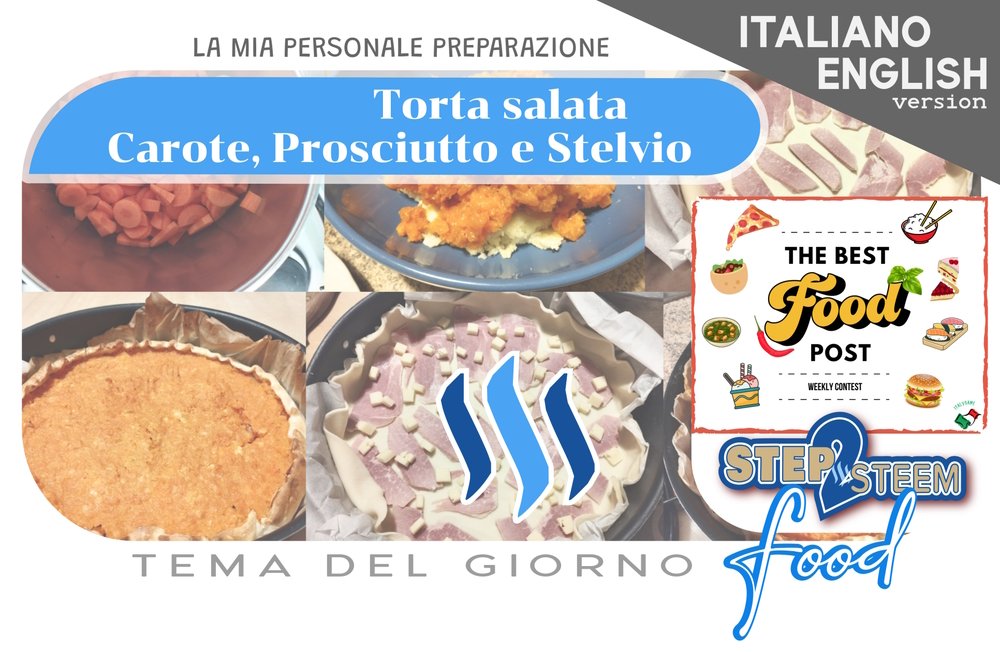You can find the ENGLISH translation after the Italian text.
Tutti gli usi dei contenuti presenti in questo post – e dei loro derivati – sono strettamente proibiti, fatta eccezione la diffusione senza modifiche attraverso canali media e social media.

Ciao!
Oggi pubblico questo post tentando la fortuna nel contest organizzato nella comunità Italy da italygame: THE BEST FOOD POST. Per l'occasione, propongo una ricetta preparata alcune settimane fa, e di cui ho scattato qualche foto così da poterla riproporre online. Questa volta parliamo di una torta salata, semplice e farcita con carote, prosciutto cotto e formaggio Stelvio.
Gli INGREDIENTI e l'ATTREZZATURA
Per tre persone, le DOSI APPROSSIMATIVE CONSIGLIATE sono:
- Patate, 150 g
- Carote, 800 g
- Prosciutto cotto, 100-120 g
- Formaggio Stelvio, 80-100 g
- Pasta sfoglia, 200 g
- Olio extravergine d'oliva
- Aglio
- Acqua
- Sale
e l'ATTREZZATURA necessaria è:
- Pentole
- Fornello
- Forno
- Piatto
- Coltello, forchetta e cucchiaio
- Teglia
- Scodella
- Pelacarote (facoltativo)
- Carta da forno (facoltativa)
- Tagliere (facoltativo)
La PREPARAZIONE del piatto
Prendiamo i primi due ingredienti, le carote e la patata. Sbucciamole con uno strumento apposito oppure con un coltello. Tagliamo le carote a rondelle fini: più sono ridotte le dimensioni, meglio sarà. Versiamole in una pentola con un filo d'olio, un poco di sale, un sottile strato d'acqua e mezzo spicchio d'aglio. Accendiamo il fornello e lasciamo cuocere le carote per circa 15 minuti. Per capire quando saranno pronte, usiamo una forchetta e accertiamoci che possa passare senza fatica da una parte all'altra della rondella.

Prendiamo poi le patate sbucciate, tagliamole a pezzetti e mettiamole in un'altra pentola, coprendole d'acqua. Aggiungiamo un altro poco di sale e accendiamo il fornello, lasciandole cuocere circa 8-10 minuti da quando l'acqua bollirà. Nel caso le patate fossero più grandi, servirà più tempo per la cottura.
Una volta cotte, prendiamo le patate calde e spezzettiamole fino a creare un grossolano purè, usando una forchetta oppure uno strumento apposito. Facciamo la stessa cosa con le carote, poi aggiungiamo a una ciotola entrambe le preparazioni. Assicuriamoci che non manchi sale, assaggiando: nel caso, aggiungiamone quanto basta. Aggiungiamo anche un poco d'olio se il miscuglio sembrasse troppo asciutto.

Prendiamo poi della pasta: io ho utilizzato una pasta sfoglia già pronta, per cui non aggiungerò qui la preparazione. Se vuoi, puoi cercare online e usare qualsiasi altra ricetta per creare una buona base di pasta per torte salate. Fai attenzione a usare una teglia che permetta di creare dei bordi di pasta: non troppo alti, ma è importante che ci siano.
Dopo averla stesa all'interno di una teglia coperta da carta da forno (se non la hai, puoi usare dei grassi vegetali o animali spalmati su tutta la superficie della teglia), prendiamo del prosciutto cotto. Tagliamo a strisce più spesse (che possono essere sostituite con fette sottili a seconda dei tuoi gusti) e posizioniamole sul fondo di pasta.

Tagliamo a fette o a dadini del formaggio Stelvio, un tipo di formaggio saporito che puoi anche sostituire con della Fontina o con altri formaggi di mucca stagionati dal sapore deciso. Anche in questo caso, aggiungiamolo sulla base di pasta.

Per ultimo, prendiamo la miscela di carota e patata e versiamola sulla base di pasta. Se la pasta ai bordi della teglia sporge più dello strato di farcitura, rivoltala verso l'interno, adagiandola sulla miscela.
Accendiamo il forno, seguendo i consigli specifici per la pasta che utilizziamo. Io ho adottato i classici 180 gradi a forno ventilato, con una cottura della durata di circa 25-30 minuti. Nel caso usassimo forni a più alte temperature (come quelli a legna oppure forni elettrici più tecnologici), accorciamo il tempo di cottura. Infine sforniamo e... buon appetito.

FINITO
E anche oggi abbiamo terminato. Questa volta la ricetta è un po' più laboriosa, non tanto per le conoscenze tecniche richieste quanto per il tempo necessario alla preparazione. Diciamo un'ora e mezza, tanto per dare un'idea.
E nulla da aggiungere. Anche per oggi sono arrivato alla fine. Spero che questo post ti sia piaciuto e che ti abbia lasciato uno spunto utile per qualche idea da portare sulla tavola. Io ti saluto e spero che ci ritroveremo in un futuro post. Mi raccomando: se ti è piaciuto il post, lascia un upvote! ;)
Saluti da me e dall'Italia!

Questo post partecipa al progetto sperimentale Penny4thoughts.
All the uses of the contents herein - and their derivatives - are strictly prohibited without the explicit consent of the author, except for dissemination without modification through social media channels.

Hello!
Today I publish this post trying my luck in the contest organized in the Italy community by italygame: THE BEST FOOD POST. Today I propose a recipe prepared a few weeks ago, of which I took some photos to show online. This time we're talking about a savoury pie, simple and filled with carrots, cooked ham and Stelvio cheese.
The INGREDIENTs and the EQUIPMENTs
For three, the approximative suggested doses are:
- Potatoes, 150 g
- Carrots, 800 g
- Cooked ham, 100-120 g
- Stelvio cheese, 80-100 g
- Puff Pastry, 200 g
- Extra virgin olive oil
- Garlic
- Water
- Salt
and the necessary equipments are:
- Pots
- Stove
- Oven
- Plate
- Knife, fork and spoon
- Baking tray
- Bowl
- Carrots peeler (facultative)
- Baking paper (facultative)
- Chopping board (facultative)
The PREPARATION of the dish
Let's take the first two ingredients, the carrots and the potato. Peel them with a special tool or with a knife. Let's cut the carrots into thin rounds: the smaller the size, the better. Pour them into a pot with a drizzle of oil, a little salt, a thin layer of water, and half a clove of garlic. Let's turn on the stove and let the carrots cook for about 15 minutes. To understand when they're ready, use a fork and make sure it can pass effortlessly from one side of the washer to the other one.

Then, let's take the peeled potatoes, cut them into small pieces, put them in another pot, and cover with water. Add a little more salt and light the stove, letting them cook for about 8-10 minutes from when the water begins to boil. If the potatoes are bigger, the cook will be longer.
Once cooked, take the warm potatoes and break them up to create a coarse purée, using a fork or a special tool. Let's do the same thing with the carrots, then add both preparations to a bowl. Let's make sure that there is no shortage of salt, by tasting: if necessary, add just enough. We also add a little oil if the mixture seems too dry.

Then let's take some pastry: I used a ready-made puff pastry, so I won't add the preparation here. If you want, you can search online and use any other recipe to make a good pastry. Be careful to use a bakery tray that allows the edges of the dough to be created: not too high, but it's important that they are there.
After having spread it inside a bakery tray covered with baking paper (if you don't have it, you can use vegetable or animal fats spread over the entire surface of the tray), let's take the cooked ham. Let's cut into thicker strips (which can be replaced with thin slices according to your taste) and place them on the pastry base.

Let's cut the Stelvio cheese into slices or cubes, a type of tasty cheese that you can also replace with Fontina cheese or other seasoned cow's milk cheeses with a strong flavour. Again, let's add it to the pastry base.

Lastly, take the carrot-potato mixture and pour it over the pasta base. If the pastry at the edges of the pan protrudes more than the filling layer, turn it inwards, placing it on the mixture.
Let's turn on the oven, following the specific recommendations for the pastry used. I adopted the classic 180 degrees fan-oven-mode, with cooking lasting about 25-30 minutes. If we use higher temperature ovens (such as wood-burning ones or more technological electric ovens), we have to shorten the cooking time. Finally, let's bake and... enjoy your meal.

The END
And we reached the end again. This time the recipe is a little more laborious, not so much for specific technical knowledge as for the time necessary for the preparation. Let's say 90 minutes, just to give you an idea.
And nothing more, even for today I reached the end. I hope you enjoyed this post and it left you with a useful cue for some ideas to bring to the table. I greet you and I hope that we will meet again in a future post. I recommend: if you liked the post, leave an upvote! ;)
Greetings from me and from Italy!

This post join the Penny4thoughts experimental project.

